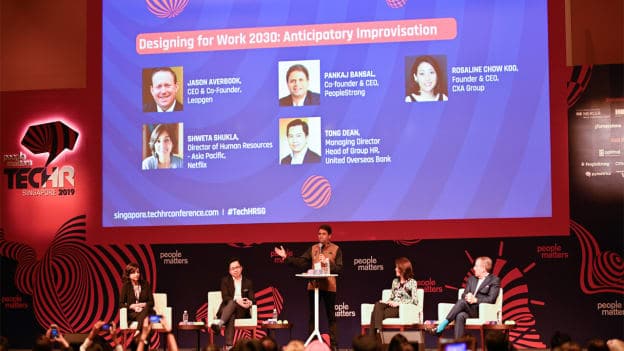Digitization and smart automation will rule the workplace trends in 2030.
Combinations of machine learning, robotics, artificial intelligence, and other technologies are already transforming the workplace at an unprecedented pace.
While the role of the HR will shift from transactional to a more strategic role, they also have the responsibility to help organizations and the talent navigate through the changing workplace dynamics.
To discuss these changing workspaces and structures, a panel of HR and business leaders including Jason Averbook, CEO & Co-Founder, Leapgen, Rosaline Chow Koo, Founder & CEO, CXA Group, Shweta Shukla, Director of Human Resources – Asia Pacific, Netflix and Tong Dean, Managing Director, Head of Group HR, United Overseas Bank came together in a session moderated by Pankaj Bansal, Co-founder & CEO, PeopleStrong and shared a few HR practices that need to change.
Here are some ways in which HR professionals have to change the way they approach people and work
Stop putting people in boxes
For ages, graphs, curves, and forced distributions have been HR professional’s best friends when it comes to identifying, describing and solving people challenges.
“We have achieved too many ‘measurements’ in corporate life today. We need to simplify”: Tong Dean, United Overseas Bank. @peoplestrong pic.twitter.com/n9tli2LPzU
— Mrigank Tripathi (@mtripathi) February 28, 2019
But as the demographics and the dynamics of the talent, we have now and will have in the future, transforms and becomes more complicated, these tools have to be replaced or transformed.
Shweta Shukla, Director of Human Resources – Asia Pacific, Netflix said, “HR professionals spend a huge amount of time managing people’s performance and spend an ordinate amount of time putting people in boxes, curves, and forced distributions. Principally, I am not saying that it’s bad or completely redundant. But these practices create a short term behavior which does not lead to long term thinking.”
The HR teams have to shift their focus now on building more sustainable policies and culture which would require them to visualize and look at people’s problems from beyond closed samples, that tell only part of the story.
“Culture eats EVERYTHING for breakfast, lunch + dinner”: Rosaline, CXA group.
Build personalized and relevant solutions for talent using the power of data
The one size fits all approach is already fading away.
Organizations today have a diverse workforce with diverse needs. Besides that, it’s time that HR professionals understand that not every individual in the organization will be at the same stage in their life.
What might work for one, might be completely worthless for another.
This holds true in terms of benefits, perks, L&D programs, and many other aspects.
“Benefits need to be designed on the basis of what we need as an individual. For instance, what the family situation is,” suggested Shukla.
The one way in which HR and business leaders can bring this to practice is through technology.
The power of data, that can be pulled out using the current and upcoming new solutions in the market can be leveraged to construe people challenges and make decisions.
The other way in which tech can be useful is through an ecosystem that can connect all of the vendors related to employees benefits which they can tailor for themselves as per their requirements.
Rosaline Chow Koo, Founder & CEO, CXA Group said, “In the future, we would be able to have ecosystems that actually connects all the vendors that have anything to do with employees benefits and allow employees to tailor these benefits for themselves. For example, instead of spending all their money on insurance (only if they get sick or injured), in the future the employees can take that money and redeploy it for what they need for themselves and their family. They could invest it in anything, from yoga to mindfulness.”
“This system would further help the company in gathering and consolidating all the data to understand the employees better,” added Chow Koo.
Have a strong focus on fundamentals
A system or process can only be scaled or be transformed if the base is strong.
For HR professionals to take the next leap, it is important that their fundamentals are clear and the foundation they design the workplace for the future on is strong.
Dean Tong, Managing Director, Head of Group HR, United Overseas Bank shared, “Many organizations often lack the right foundation and hence fail to scale up. If the basics are strong, it helps you have the right perspective and make better decisions.”
These strong fundamentals also help in deciding the right solution for the people and work challenge most relevant for a particular organization.
“We have achieved too many ‘measurements’ in corporate life today. We need to simplify”: Tong Dean, United Overseas Bank.
A good combination of basics and tech can thus help the HR teams, business leaders and managers create an awesome employee experience that fits the workplace needs, whether current or future.
Change the way everyone looks at HR
Jason Averbook, CEO & Co-Founder, Leapgen emphasized that both HR service providers and HR professionals have to stop referring to people as ‘users.’
An open and connected system to ensure people data comes to the fore: Rosaline Chow, CXA.
The language and the way they represent the talent at their workplace and the way HR professionals interact with them needs to change.
“Why do you still use old ERP systems that don’t open and integrate?”. Jason gives the answer! Are you getting into the ‘marketecture’??@peoplestrong @PankajBansalPB @insatiableankur @kamakshipant @ShellySinghSaha pic.twitter.com/56rvZlWg9y
— Mrigank Tripathi (@mtripathi) February 28, 2019
He said, “An employee can not necessarily understand the difference between different functional departments within HR.
These silos need to break.
Employees come to HR with an expectation of a solution and HR professionals can’t just shuffle them among different functions but rather give them the solution.”
“We gotta trash many things to get to 2030. The biggest of them is trashing the Business partner… managing repetitive queries. We NEED to automate”: Jason Averbook, CEO LeapGen.
This is where technology can be useful and allow HR business partners to truly focus on solving the problems for the talent proactively.
By automating all or most of the transactional and operational functions HR professionals can play the role of a strategic leader who owns and leads the people agenda for business from the front.
“If it’s not open it won’t work. For a world where Work, work spaces and workforce all will be boundary less, it is important for technology, data and users to stay “connected” – Pankaj Bansal, CEO at PeopleStrong
[callout](This article is based on a panel discussion on ‘Designing for Work 2030: Anticipatory Improvisation,’ and originally published on People Matters )[/callout]





